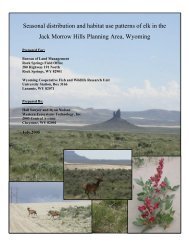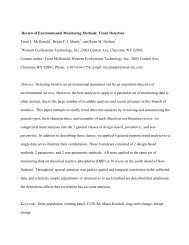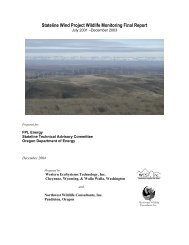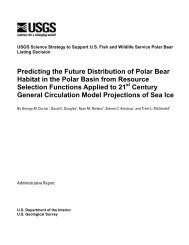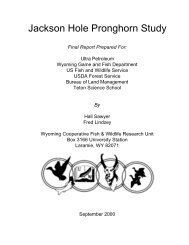baseline avian studies for the proposed maiden wind ... - WEST, Inc.
baseline avian studies for the proposed maiden wind ... - WEST, Inc.
baseline avian studies for the proposed maiden wind ... - WEST, Inc.
- No tags were found...
Create successful ePaper yourself
Turn your PDF publications into a flip-book with our unique Google optimized e-Paper software.
FINAL REPORTMAIDEN WIND PROJECT BASELINE AVIAN STUDIEShowever, <strong>the</strong> emphasis of <strong>the</strong> surveys was passerines within a 100 m radius of <strong>the</strong> point.All paired-plots were visited once each month in May, June, and July.3.4 General Wildlife ObservationsThe objective of <strong>the</strong> general wildlife observations was to document o<strong>the</strong>r wildlifeoccupying <strong>the</strong> study area. All mammals, reptiles, amphibians, and <strong>avian</strong> species ofinterest (e.g., state species of concern 2 , raptors, waterfowl, upland game birds) sightedwhile field observers were on-site or traveling between plots were recorded on datasheets <strong>for</strong> incidental observations. The data recorded are similar to those recorded duringo<strong>the</strong>r surveys. The observation number, date, time, species, number, sex/age class, heightabove ground (<strong>for</strong> birds), and habitat were recorded and <strong>the</strong> point of first observation wasmapped on a project map with a corresponding observation number.3.5 Vegetation MappingThe objective of <strong>the</strong> vegetation mapping was to characterize habitats in <strong>the</strong> area andpotential <strong>avian</strong> community that may be impacted. The vegetation of <strong>the</strong> study area wasmapped on 1:24000 scale USGS topographic maps based on aerial photos (BentonCounty) and ground observations. In<strong>for</strong>mation from <strong>the</strong> vegetation mapping was used tohelp locate <strong>avian</strong> survey points, describe habitat used by <strong>avian</strong> species observed, anddetermine <strong>the</strong> need <strong>for</strong> more detailed vegetation impact analyses. For each vegetationtype identified in <strong>the</strong> study area, a list of dominant species was compiled based on fieldsurveys and from previous work when available.3.6 Data Compilation and Report Preparation3.6.1 Data Compilation and StorageA database was created to store, retrieve and organize field observations. Data from field<strong>for</strong>ms were keyed into electronic data files using a pre-defined <strong>for</strong>mat that madesubsequent data analysis straight<strong>for</strong>ward. All field data <strong>for</strong>ms, field notebooks, andelectronic data files have been retained <strong>for</strong> future reference.3.6.2 Quality Assurance/Quality Control (QA/QC)QA/QC measures were implemented at all stages of <strong>the</strong> study, including in <strong>the</strong> field,during data entry, during data analysis, and report writing. At <strong>the</strong> end of each survey day,each observer was responsible <strong>for</strong> inspecting his or her data <strong>for</strong>ms <strong>for</strong> completeness,accuracy, and legibility. The study team leader periodically reviewed data <strong>for</strong>ms toensure completeness and legibility; any problems detected were corrected. Any changesmade to <strong>the</strong> data <strong>for</strong>ms were initialed and dated by <strong>the</strong> person making <strong>the</strong> change.The electronic database was compared to <strong>the</strong> original data sheets by randomly choosingelectronic records and verifying <strong>the</strong>se with <strong>the</strong> field data sheet. Any errors detected werecorrected by referencing <strong>the</strong> raw data <strong>for</strong>ms and/or consulting with <strong>the</strong> observer(s) whocollected <strong>the</strong> data. Any irregular codes detected, or any data suspected as questionable,2 State Species of Concern are collectively state endangered, threatened, sensitive, and candidate species.6




